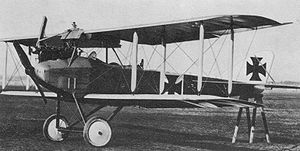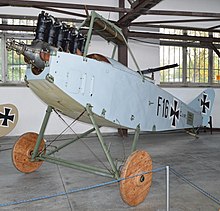Albatros C.I
| Albatros C.I | |
|---|---|
 | |
| Určení | průzkumný letoun |
| Výrobce | Albatros Flugzeugwerke |
| Zařazeno | 1915 |
| Vyřazeno | 1917[1] |
| Uživatel | Luftstreitkräfte Polské letectvo Litevské letectvo |
| Vyrobeno kusů | 745 |
| Varianty | Albatros C.III |
| Některá data mohou pocházet z datové položky. | |
Albatros C.I byl prvním ze série víceúčelových dvouplošníků vyráběných společností Albatros Flugzeugwerke během 1. světové války. Letoun byl odvozen od neozbrojeného letounu Albatros B.II. Letoun C.I měl však prohozená místa pilota a pozorovatele. Pilot seděl na předním sedadle, zatímco pozorovatel seděl vzadu a ovládal i pohyblivý kulomet Parabellum KG14 ráže 7,92 mm.
Vývoj a popis
Když se na počátku roku 1915 objevil první letoun C.I, jeho dobrá ovladatelnost a výkonný řadový motor Benz Bz.III s výkonem 110 kW (150 k) mu dával výhodu nad většinou soudobých spojeneckých letounů.[2] Během vývoje byly na letoun montovány postupně i silnější motory, například Mercedes D.III o výkonu 118 kW (160 k), což vyvrcholilo motorem Argus As III s výkonem 130 kW (180 k), který umožňoval konečné verzi C.Ia dosáhnout rychlosti 140 km/h (87 mph) na hladině moře s operačním dostupem 3 000 m (9 840 stop).[1] Varianta se zdvojeným řízením označená C.Ib byla postavena jako cvičný letoun společností Mercur Flugzeugbau. Dalším vylepšením tohoto typu vzniknul letoun Albatros C.III, který se stal nejvyráběnějším letounem Albatros řady C.
Popis konstrukce
Trup měl dřevěnou kostru potaženou překližkovými panely, díky kterým byl velmi pevný a tuhý. Křídla byla dvoupříhradová s dřevěnou kostrou a se značně zakřiveným profilem díky posunutí předního nosníku výrazně vpřed a umístění zadního do poloviny hloubky. Potah byl z plátna stejně jako u křidélek a ocasních ploch, které měly kostru z ocelových trubek. Z nich byly vyrobeny i vzpěry mezi křídly a podvozkové vzpěry. V zadní části podvozku byla pak výkyvná ostruha, která sloužila jako brzda při dojezdu a byla ovládaná pilotem. Na bocích trupu byly umístěny regulovatelné vícedílné chladiče vody. U verze C.Ia byl montován čelní chladič nesený před náběžnou hranou horního křídla, což vedlo ke zlepšení aerodynamických vlastností letounu.
Operační historie
Letoun C.I byl používán hlavně jako průzkumný a pozorovací letoun, přesto však dosáhl úspěchů i jako stíhací letoun. Pilot Oswald Boelcke nahlásil své první vzdušné vítězství při letu na letounu C.I, přičemž kulomet obsluhoval pozorovatel Lt. von Wühlisch. Nejslavnější německé eso 1. světové války Manfred von Richthofen také začínal svou kariéru jako pozorovatel na letounu C.I na východní frontě.
Varianty

C.I
- Dvoumístný průzkumný letoun. První sériová verze.
C.Ia
- Vylepšená verze poháněná silnějším motorem Argus As III vyráběná společnostmi BFW a LFG.
C.Ib
- Cvičná verze se zdvojeným řízením vyráběná společností Mercur Flugzeugbau.
C.I-V
- Experimentální verze. Postaven 1 stroj.
Specifikace (C.I)

Technické údaje pocházejí z publikace „German aircraft of the First World War“.[3]
Technické údaje
- Posádka: 2
- Rozpětí: 12,9 m
- Délka: 7,85 m
- Výška: 3,14 m
- Nosná plocha: 40,4 m²
- Plošné zatížení: ? kg/m²
- Prázdná hmotnost: 875 kg
- Max. vzletová hmotnost: 1 190 kg
- Pohonná jednotka: 1× řadový motor Mercedes D.III
- Výkon pohonné jednotky: 150 k (110 kW)
Výkony
- Cestovní rychlost: ? km/h ve výšce ? m
- Maximální rychlost: 132 km/h (82,5 mph) ve výšce ? m
- Dolet: ? km
- Dostup: 3 000 m (9 840 stop)
- Stoupavost: 1,7 m/s (336,5 stop/min)
- Vytrvalost: 2,5 h
Výzbroj
- 1× kulomet Parabellum MG14 ráže 7,92 mm na místě pozorovatele
Uživatelé
Odkazy
Reference
V tomto článku byl použit překlad textu z článku Albatros C.I na anglické Wikipedii.
Literatura
- ANGELUCCI, Enzo. The Rand McNally Encyclopedia of Military Aircraft, 1914-1980. San Diego, California: The Military Press, 1983. ISBN 0-517-41021-4. (anglicky)
- COWIN, H.W. German and Austrian Aviation of World War I. Oxford, UK: Osprey Publishing Ltd., 2000. ISBN 1-84176-069-2. (anglicky)
- GRAY, Peter; THETFORD, Owen. German aircraft of the First World War. Londýn: Putnam, 1970. ISBN 0-370-00103-6. (anglicky)
- VAN WYNGARDEN, G. Early German Aces of World War I. Oxford, UK: Osprey Publishing Ltd., 2006. Dostupné online. ISBN 1-84176-997-5. (anglicky)
- HORNÁT, Jiří. Albatros C-1. Letectví a kosmonautika. Prosinec 1990, roč. LXVI, čís. 24, s. 35. ISSN 0024-1156.
Související články
Související vývoj
Podobná letadla
- Royal Aircraft Factory B.E.2
- LVG C.II
- Rumpler C.I
Externí odkazy
 Obrázky, zvuky či videa k tématu Albatros C.I na Wikimedia Commons
Obrázky, zvuky či videa k tématu Albatros C.I na Wikimedia Commons - Letoun Albatros C.I na stránkách Polského leteckého muzea. (polsky)
- Letecká fotografie letounu C.I na webu Airliners.net.
- Albatros C.I na stránkách valka.cz. (česky)
Média použitá na této stránce
Flag of the Germans(1866-1871)
Flag of the Germans(1866-1871)
Autor: Alan Wilson , Licence: CC BY-SA 2.0
The Albatros C.I was the first of the successful C-series of two-seat general-purpose biplanes built by Albatros Flugzeugwerke during World War I. Based on the unarmed Albatros B.II, the C.I reversed the pilot and observer seating so that the observer occupied the rear cockpit which was fitted with a ring-mounted 7.92 mm (0.312 in) Parabellum MG14 machine gun.
While the C.I was operated mainly in a reconnaissance and observation role, it also had some success as an early fighter aircraft - Oswald Boelcke claimed his first victory while flying a C.I with Lt. von Wühlisch as the gunner. Germany's most famous World War I aviator, Manfred von Richthofen, also began his career as an observer in the C.I on the Eastern Front.
As with the other WW1 aeroplanes at Krakow, this is the only surviving example of it's type. The restored fuselage is on display in the 'WW1' hangar at the Muzeum Lotnictwa Polskiego. Krakow, Poland. 23-8-2013.
It's history is given in the following info taken from the museum website:-
"The Albatros C.I was a two seat, all-wood German reconnaissance biplane. It was developed by Robert Thelen based on the earlier Albatros DD, a two seat biplane conception, designed by Ernst Heinkel just before the outbreak of the war.
According to the German designation system introduced in the spring of 1915, the "C" category comprised two-seat armed aircraft used mainly for reconnaissance, artillery spotting as well as for attacking targets on the ground. With time, the "C" aircraft would be equipped with radio equipment.
The Albatros C.I was produced in the years 1915–1918 at the Albatros Flugzeug Werke, the BFW (Bay) works, the LFG works, the MFW works and the Merkur Flugzeugbau works. A single aircraft was built at the Ostdeutsche Albatros Werke in Schneidemühl (today's Piła in Poland). The production was ceased in favour of the more modern C.III variant.
The Polish Air Force utilised 49 Albatros C.I airframes. The majority of these were taken over by the Poles on ex-Prussian territory included in the Polish state reconstituted in 1918, and a few were captured on the ex-Austrian and ex-Russian territories. Because of their low performance, the C.Is were qualified as aircraft for aeronautical schools. During the Polish-Bolshevik War in 1919–1920, they were flown in combat. After the war had ended, the aircraft were in service with the aeronautical schools in Warsaw, Poznań, Krakow, Bydgoszcz, Toruń and Grudziądz, where the last Albatros C.I was flown as late as 1922 in the Military Flying School.
The Albatros C.I on display, serial number 197/15 comes from the third production batch delivered in 1915. As the research of the camouflage of the restored fuselage revealed, this aircraft served with the Officers School Detachment of the Radio Operators in Warsaw (occupied by the Germans in 1915–1918) and later in aeronautical school in Neuruppin. In the Museum's restoration workshop, the destroyed fuselage, powerplant and the undercarriage were restored. Additionally, the replicas of the so called "workshop" wooden wheels (used for ground manoeuvres instead of regular undercarriage in order to save the rubber, which was scarce due to allied blockade of Germany in the years 1914–1918) were fitted. The restoration of the empennage and the fuselage engine fairing is envisaged to commence in future."A German Albatros C.I in Poland, ca. 1915.
Akbatros C.I








